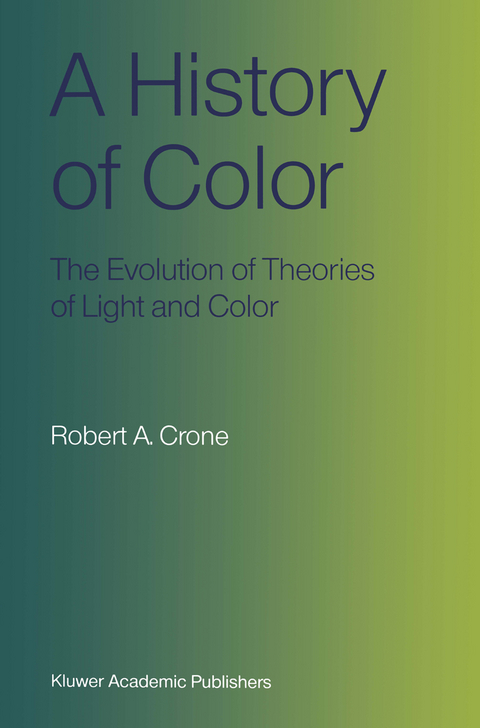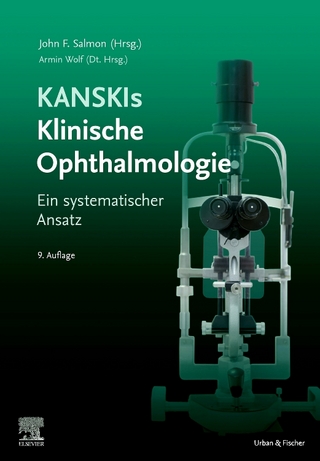
A History of Color
Springer (Verlag)
978-94-015-3941-8 (ISBN)
This is the first comprehensive text on the history of color theories since Halbertsma's book of 1947. Color is discussed in close connection with the evolution of ideas of light and vision. The book has chapters on the ancient Greek ideas of vision and color; on the contributions of Arabic science; on the Scientific Revolution from Kepler to Newton; on the early history of the three-color hypothesis; on the trichromatic theory and defective color vision; and on Goethe's, Schopenhauer's and Hering's theories. New understanding of the structure and functions of the retina and the brain finally results in the modern science of color vision.
A History of Color has been written for ophthalmologists, optometrists and others who are interested in visual science and its history. The book requires no specialized knowledge.
I Color theory in the ancient world.- Empedocles’ four elements and four colors.- The four-color doctrine.- Atomism and idealism: Democritus and Plato.- The empiricism of Aristotle.- The influence of Plato and Aristotle on science.- The Hellenistic and Roman era.- Neoplatonism.- The end of ancient scholarship.- II The Middle Ages.- The early Middle Ages.- The visual science of the Islamic world.- The controversy about visual rays.- Ibn Al-Haytham (Alhazen).- Alhazen’s theory of vision.- Colors.- The refraction of light.- The science of vision and colors in the prime of the Middle Ages.- The perspectivists.- III The Renaissance.- Color in the Renaissance.- Optics in the Renaissance.- Johannes Kepler.- IV Light, color and vision during the scientific revolution.- The scientific revolution.- Kepler and Galileo.- Bacon, Gassend and Descartes.- Descartes and vision.- New theories of light and color.- The speed of light.- The refraction of light.- The rainbow.- The chemical colors.- The color theories of opponents of the corpuscular hypothesis.- V Newton.- A new theory of light and color.- Newton’s color system.- The barycentric system.- The physiology of color vision.- VI From Newton to Young.- The reception of Newton’s color theory.- Supporters of the medium hypothesis.- Intermezzo: achromatic lenses.- Supporters of the corpuscular hypothesis.- Conservative Aristotelians.- Practitioners on the classification of colors.- Three-color printing.- The first color triangles.- Butterflies and color-tops.- The start of color physiology.- The retina sensitive to three sorts of light?.- Thomas Young.- Theory of light.- Fresnel.- Invisible light.- Theory of color vision.- VII Classical-romantic color theory in Germany.- Runge.- Goethe.- Intermezzo: subjective colors beforeGoethe.- Back to Goethe.- Schopenhauer.- VIII Disorders of color vision.- Dalton.- Goethe.- Schopenhauer.- Seebeck.- IX The mixing of colors.- Primary colors and the mixing of pigments.- Optic color mixing.- Wünsch.- Chevreul.- Voigt, Young and Forbes.- Helmholtz.- Mixing spectral colors.- X The trichromatic theory.- Helmholtz.- Grassmann.- Limitations of Grassmann’s system.- Maxwell.- Colorimetry.- The fundamental sensation curves.- Trichromatism and dichromatism.- Arthur König.- Anomalous trichromatism.- Psychophysics.- Aubert and Mach: color as subjective quality.- XI Hering’s four-color theory Zone theories.- Theory of the four opponent colors.- Fick’s hypothesis.- Zone theories.- XII Anatomy and physiology of the visual system between 1600 and 1900.- Anatomy of the retina.- The neural structure of the retina.- Anatomy of the visual pathways.- The duplicity theory.- Day-blindness and night-blindness.- Visual pigment.- The Purkinje shift.- The photopic luminous efficiency function (V lambda function).- Dark adaptation.- XIII The twentieth century.- The quantum theory.- The impact of the quantum theory on the science of vision and color.- The physics of color.- Photochemical processes.- The quantum theory and the limits of vision.- The absolute threshold of vision.- The relative threshold of vision.- The relative thresholds of color vision.- Our spectral window and the quantum theory.- Other important aspects of the twentieth century color theory.- The further development of color theories.- The trichromatic theory.- Luminance and color.- Zone theories.- Electronmicroscopy of the retina.- New facts about color vision defects.- Heredity.- Tritanopia.- Monochromatism.- The visual pigments.- The rod-pigment.- The cone-pigments.- Retinal densitometry.- Conehistochemistry.- Microspectrophotometry.- The structure of the cone pigments.- The evolution of color vision.- The neurophysiology of the retina.- Action potentials.- The horseshoe crab.- The visual nerve of the frog.- The receptive field.- Stimulation of the retinal ganglion cells with colored lights.- Electrophysiology of the cones.- Opponent processes.- The advantages of an opponent organization.- Color and luminance channels from retina to visual cortex.- Color psychology in the twentieth century.- The classification of colors.- The names of colors.- Contrast.- The influence of boundaries.- Color adaptation and color constancy.- The cortical color mechanism.- Functional specialization in the areas of the visual cortex.- Appendix and synopsis; what is color?.- Color and presciantific man.- The history of color theory.- Aristotle.- Alhazen, Bacon, Kepler.- Mechanicism and the subjectivity of the concept of color.- From Newton to the trichromatic theory.- Hering.- Modern color physiology.- The future of color science.- Notes.- Acknowledgments.- References.
| Zusatzinfo | 7 Illustrations, color; 29 Illustrations, black and white; 292 p. 36 illus., 7 illus. in color. |
|---|---|
| Verlagsort | Dordrecht |
| Sprache | englisch |
| Maße | 155 x 235 mm |
| Themenwelt | Geisteswissenschaften ► Geschichte |
| Medizin / Pharmazie ► Medizinische Fachgebiete ► Augenheilkunde | |
| ISBN-10 | 94-015-3941-3 / 9401539413 |
| ISBN-13 | 978-94-015-3941-8 / 9789401539418 |
| Zustand | Neuware |
| Haben Sie eine Frage zum Produkt? |
aus dem Bereich


